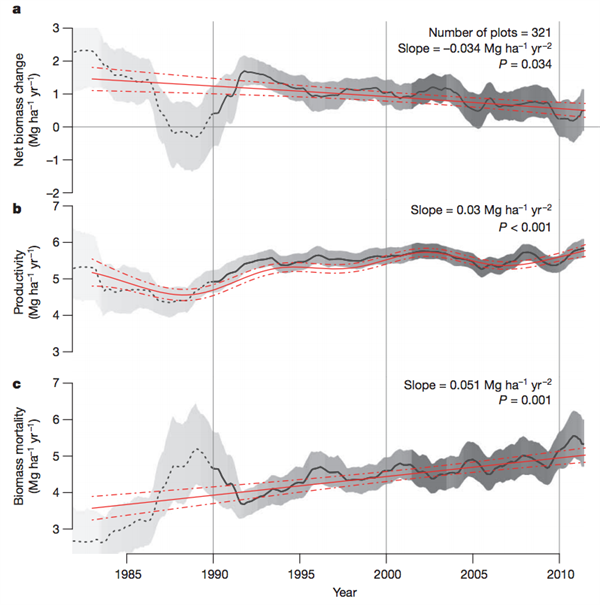
Amazon at dawn | P. van der Sleen
The amount of carbon that the Amazon rainforest is absorbing from the atmosphere and storing each year has fallen by around a third in the last decade, says a new 30-year study by almost 100 researchers.
This decline in the Amazon carbon sink amounts to one billion tonnes of carbon dioxide - equivalent to over twice the UK's annual emissions, the researchers say.
If this pattern exists in other forests around the world, deeper cuts in human-caused carbon dioxide emissions are needed to meet climate targets, the researchers say.
Three billion trees
The Amazon rainforest is the largest rainforest in the world. Spanning nine countries in South America, it's 25 times the size of the UK.
Using a process known as photosynthesis, the Amazon's three billion trees convert carbon dioxide, water and sunlight into the fuel they need to grow, locking up carbon in their trunks and branches.
As they grow, Amazon trees account for a quarter of the carbon dioxide absorbed by the land each year. Studies suggest that as human-caused carbon dioxide emissions increase, forests will absorb and store more carbon, assuming they have enough water and nutrients to grow.
But a new study, published today in Nature, suggests the Amazon has passed saturation point for how much extra carbon it can take up.
Diminishing carbon sink
A team of almost 500 people monitored trees in more than 300 sites across eight countries. Between 1983 and 2011, the researchers measured the trees in each plot, recording the number, size and density to calculate how much carbon each one stored.
The trees took up more carbon and grew more quickly during the 1990s, before levelling off since the year 2000. You can see this in the middle chart below.
Top graph shows trend in biomass (i.e. the amount of carbon stored), middle graph shows trend in productivity (i.e. tree growth), and the bottom graph shows trend in biomass mortality (i.e. tree deaths). Data before 1990 (dotted black line) was from a small number of sites, so there is more variation in these years. Source: Brienen et al. (2015)
But during this growth spurt, Amazon trees have been dying off more quickly, as the bottom graph shows.
The combination of flat growth rate and increasing tree deaths means the amount of carbon the Amazon stores has declined by around 30% since the 1990s, the researchers say. You can see this in the top graph.
Live fast, die young
So what is causing more trees to die? Co-author Prof Oliver Phillips from the University of Leeds, tells Carbon Brief it could be down to the growth spurt fuelled by rising carbon dioxide levels:
"The faster trees grow, the sooner they reach maturity, and the sooner they may eventually age. "
As tall trees are more vulnerable to high winds and drought, faster growth may also be putting trees at risk from weather extremes, Phillips says. During the Amazon droughts in 2005 and 2010, for example, the researchers found short-term peaks in deaths of large trees. Though the overall trend of more trees dying began before either drought, the researchers say.
In an accompanying News & Views article, Prof Lars Hedin, professor of ecology and evolutionary biology at Princeton University, also points to drought as a possible underlying reason for declining carbon storage:
"A more likely explanation is that the influence of one or more constraining factors, such as water availability, temperature stress or nutrient limitation, has increased as forest biomass has expanded."
But the exact causes don't change the overarching finding that the forest is storing less carbon, says lead author Dr Roel Brienen, also from the University of Leeds:
"Regardless of the causes behind the increase in tree mortality, this study shows that predictions of a continuing increase of carbon storage in tropical forests may be too optimistic."
Carbon sinking
We won't see an immediate effect of declining Amazon carbon storage on atmospheric carbon dioxide levels, the researchers say. The carbon from dead trees is released slowly as they decompose. But apart from the fraction of carbon that ends up in the soil on the forest floor, the rest will eventually reach the atmosphere.
The key question now is whether carbon uptake is falling in other forests too, says Prof Peter Smith from the University of Aberdeen, coordinating lead author of the Agriculture, Forestry and Other Land Use chapter of the latest Intergovernmental Panel on Climate Change report:
"It is not known if this trend is replicated more widely across tropical forests, but it does show that we need more measurements to quantify this elsewhere."
If declining carbon storage does turn out to be more widespread, that would spell bad news for the climate, Smith says:
"Until now, the biosphere has been re-absorbing a proportion of the carbon dioxide we have released through fossil fuel burning and land use change. If that re-absorption declines as suggested here, more carbon dioxide will remain in the atmosphere, thereby accelerating climate change."
Forests have been doing as a huge favour for decades, says Phillips. But the new study shows forests' capacity to buffer climate change is shrinking, which means the need to reduce emissions is rising at the same time.
Brienen, R.J.W et al. (2015) Long-term decline of the Amazon carbon sink, Nature,doi:10.1038/nature14283
Hedin, L.O. (2015) Signs of saturation in the tropical carbon sink, Nature, doi:10.1038/519295a
http://www.carbonbrief.org/blog/2015/03/amazon-rainforest-is-taking-up-a-third-less-carbon-than-a-decade-ago/








No comments:
Post a Comment